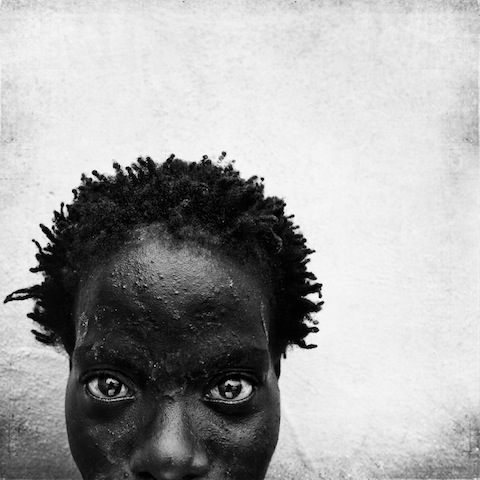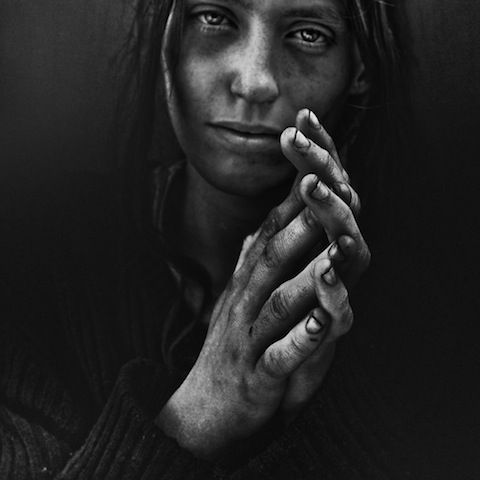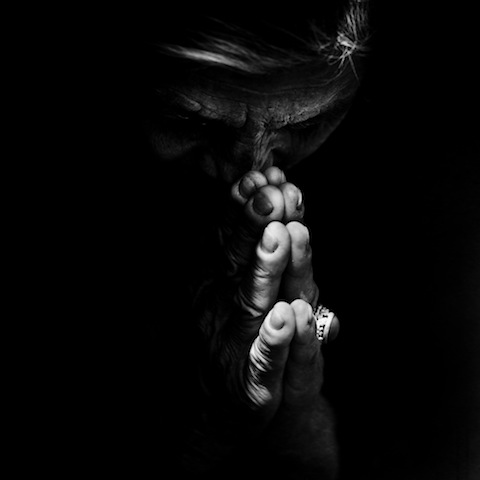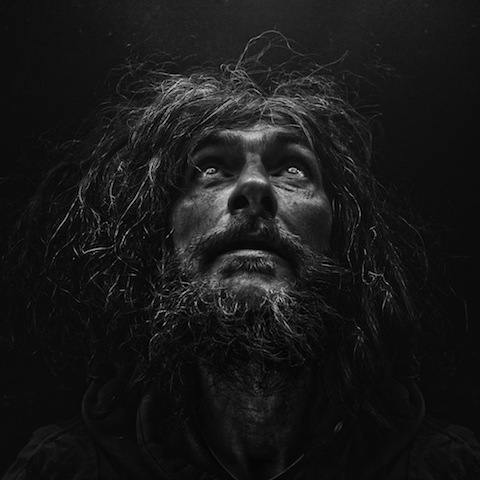Persone senza fissa dimora, uomini e donne esclusi dall’attività sociale incontrati camminando per le strade dell’Europa e degli Stati Uniti. Sono i soggetti che Lee Jeffries ha deciso di immortale per ‘Homeless‘ un progetto fotografico nato quasi per caso cinque anni fa, quando il fotografo era a Londra per una maratona e rubò uno scatto ad una ragazza senzatetto. La reazione indispettita della ragazza gli ha fatto cambiare idea su quello che finora era stato il suo approccio con la fotografia. Da allora, per ‘Homeless’, i suoi scatti diventano immagine delle sue convinzioni e della sua compassione per il mondo. Il suo lavoro fino al 12 gennaio 2014 sarà in mostra al museo di Roma in Trastevere, in prima mondiale. In esposizione cinquanta scatti in bianco e nero, senza didascalie o date, come senza tempo è la sofferenza rivelata dai volti fotografati, il disagio diventato stile di vita. Immagini che Jeffries ha colto vagando per le vie di Londra, Parigi, Roma, New York, Miami, Los Angeles o Las Vegas, spesso ritraendo persone che quelle stesse strade hanno come dimora.
Lee Jeffries ci ha raccontato qualcosa di più di ‘Homeless’, del suo approccio alla fotografia e dei suoi progetti futuri.

Hai girato per le strade di per immortalare i tuoi ‘homeless’. Con quali criteri sceglievi i tuoi soggetti?
Sono stato guidato dall’emozione; senza, nessuna delle immagini avrebbe funzionato. Mi piace pensare di riuscire a catturare qualcosa che colpisce il livello umano dello spettatore. Ho lavorato duramente sia alla composizione che alla fotografia astratta e spero che questo lavoro sia capace di provocare sia una ribellione che una quieta contemplazione. Le mie immagini non sono semplici ritratti, sono complesse opere d’arte che hanno bisogno di essere indagate per capire il loro vero significato.
Ogni volta che scattavi ti sei fermato con loro per sapere qualcosa di più sulle loro vite, le loro storie?
Certamente. A volte riesco a trascorrere molto tempo con la gente che fotografo. Ovviamente mi capita di sentire le loro storie ma non penso siano così importanti da essere raccontate assieme alla foto. Non mi considero un fotografo documentarista anche se le mie immagini sono molto influenzate da quel genere. Vorrei solo che le mie immagini vivano una vita propria. Preferisco, cioè, che siano le emozioni e la spiritualità che sprigionano le foto ad essere fonte di reazione, non le loro storie, non le cause che hanno spinto una persona a finire lì. Insomma, io fotografo la gente, non le circostanze.
C’è qualcuno tra di loro che ti ha colpito di più?
Mi hanno colpito tutti. Tutti quelli che incontro mi colpiscono. Non sono mai stato più felice da quando sono per strada, a contatto con le persone.Vorrei essere lì fuori più spesso.

In che differenze ti sei imbattuto? Dal punto di vista sociale, intendo. Ogni stato, ogni città, come reagisce alla presenza dei senzatetto? Ti sei fatto qualche idea?
Un senzatetto rimane tale in tutto il mondo. I sentimenti di solitudine e isolamento sono gli stessi sia Roma che a Los Angeles. La più grande differenza, parlando in larga scale, è che negli Stati Uniti in raffronto alla popolazione è molto maggiore, rispetto all’Europa, il numero dei senzatetto. Si può camminare nel distretto di Skid Row (Los Angeles) e trovarsi di fronte a centinaia di persone stese sul marciapiede per 3-4 isolati.
Le finalità di questo tuo progetto?
La fotografia è un’autodiagnosi, sia per me che per l’osservatore e il progetto vuole essere un’esplorazione della spiritualità dell’essere umano. ‘Homeless’ porta un messaggio sociale, di ingiustizia e di sofferenza. Si tratta di fede. Amore. Compassione. Riguarda tutti noi. E’ molto più di essere ‘homeless’.
La fotografia può essere il messaggio più diretto per esprimere tutto questo?
La fotografia è solo uno dei tanti modi per colpire. Sono una persona che punta molto sull’aspetto visivo per cui mi è venuto naturale scegliere questo mezzo.
Le foto sono tutte in bianco e nero, modificate al pc. Danno più forza alla foto. Sono più dirette?
Penso che in bianco e nero offra una qualità senza tempo. Adoro la sua raffinatezza e sottigliezza.

Roma ospita ‘Homeless’ in anteprima mondiale. Alcuni scatti provengono dalla Capitale. Che ricordo conservi? Cosa ti ha colpito di più?
Il mio intero portfolio nasce da Roma e ho cercato di portare l’atmosfera di tolleranza e spiritualità della città nelle mie immagini. Roma ha avuto un impatto fortissimo al mio approccio alla fotografia.
C’è uno scatto di quelli in mostra a cui sei particolarmente legato?
Sì, le mani giunte in preghiera, l’immagine firma della mostra. Il suo gioco di luci e ombre offre una bella astrazione della scena stessa.
Nella vita sei impiegato. Come ti sei avvicinato alla fotografia?
Stavo lavorando ad un componente ciclistico e c’era un bisogno di un’immagine del prodotto. Da allora ho sempre fatto tutto da me. Ho raccolto influenze da siti web come Flickr e mi sono evoluto raggiungendo lo stile di oggi. Diciamo che è una cosa che doveva succedere.
Homeless è il tuo primo progetto?
Pensano tutti che io ho fotografo solo persone senza fissa dimora. Ormai mi hanno ‘bollato’ per questo mio lavoro, è il mio marchio di fabbrica. In realtà ho fotografato bands, animali, donne e persino paesaggi.
Progetti futuri? Puoi anticiparci qualcosa?
Da un anno è mezzo ho preso parte ad un progetto di Terrence Malick e probabilmente uscirà qualcosa già l’anno prossimo. Lavoro moltissimo con la galleria francese YellowKorner e ho un nuovo progetto escluvivo con loro che spero potremo rendere noto già nel 2014.
CHI E’ LEE JEFFRIES. Nato a Manchester. Ha un fratello gemello. Maratoneta e appassionato ciclista. Con la contabilità paga le bollette e i fondi dei progetti fotografici.

Read the original interview at Lee Jeffries.
Actually in Rome there’s the first official exhibition of ‘Homeless’ by Lee Jeffries. Fifty shots in b/w without captions or dates, such as timeless is suffering revealed by faces photographed, discomfort become lifestyle. Images that Jeffries has caught wandering the streets of London, Paris, Rome, New York, Miami, Los Angeles or Las Vegas, often portraying people who have the same roads as a dwelling.
You’ve been around in the streets a lot to capture your “homeless”. With what criteria did you choose the subjects? How many pictures did you take?
Emotion. Without it none of the images would work. I like to think I capture something that appeals to the viewer on a human level. I also try very hard with composition and metaphysical qualities that I hope will provoke both a reaction and quiet contemplation. My images are not simple portraits….they are complex pieces of art that require studying to absorb their true meaning.
Every time you took a pic, do you have spent some moment with them to knew more about them life, them stories?
Yes. I can sometimes spend many hours with the people I photograph. Of course…I get to know their stories. I do not feel they are important to tell when I produce an image however. I wouldn’t consider myself as a documentary photographer although my images are very much influenced by that genre. I want my images to breathe. I prefer the emotion and spirituality of the piece to be the aspects that provoke a reaction…not a story of how that individual ended up there. I photograph “people” NOT “circumstance”
Which of them impressed you the most?
Everybody I meet. I’m never happier than when I’m out on the street meeting people. I wish I could be out there more often.
What differences did you come across? From the social point of view, I mean. Every State, every City, how it reacts to the presence of the homeless? You got any ideas?
Homelessness is homelessness no matter where in the world it happens. Feelings of loneliness and and isolation are as real in Rome as they are on Los Angeles. The biggest difference on a global scale I would say would be that the sheer numbers and demographics of homeless are far higher and more concentrated in areas of the US when compared to Europe. You can walk through Skid Row in LA and be literally confronted with hundreds of people lay out on the sidewalk in a 3 to 4 block area.
What are the aims of this your project? Is there a message you want to spread with their faces?
The project is an exploration of the spirituality of being human. Its as much an exercise in self examination (for both me and the viewer) as it is in photography. It carries a social message, a message of injustice and suffering. It’s about faith. Love. Compassion. Its about all of us. Its so much more than “being homeless”.
Do you think that photography is the most direct means to disseminate a message?
Photography is just one of many ways to influence. I’m very much a visual person so its perhaps only natural that I would choose it.
All your pics are in b/n, then processed by software. Do you think b/n has an high impact?
I think black and white affords a timeless quality. I like its sophistication and subtlety.
The Museum of Trastevere in Rome hosts your photos. Is this the first official exhibition of Homeless?
Yes, the exhibition represents a world premier of any of my work.
Some shots were done in Rome. What memories do you keep? What struck you the most?
My entire portfolio has its foundations in Rome. I try to carry the atmosphere of the city into my images from a spiritual perspective. Visiting Rome in my early period as a photographer has had a huge impact on how I approach photography.
Is there a pic, between the ones that are in the exibition, with whom you are most fond of?
Yes. My signature image. The praying hands. Its interplay of light and shadow offers a beautiful metaphysical quality to the scene itself.
In life, you are an accountant. How did you get into photography? Did You do courses, workshops or are you self-taught?
I was running a cycling component business and there was a need for product images. I am self taught from that point forward. I gathered influences from website such as flickr as I went along until you see the style that I have developed today. It all sort of “happened”.
Is Homeless your first project?
Its a popular misconception that I photograph only homeless people. I have shot bands, animals, women and even landscapes! “Lee Jeffries…the homeles photographer” is a “label” that has sort of stuck.
Future projects? Can you tell us something in advance?
For the past year and a half I have been completing a project for Terrence Malick. We may or may not see the results of that next year. I work closely with YellowKorner based out of Paris and I plan to complete exclusive assignments for them in 2014.
Lee Jeffries. Born Manchester. Identical twin. Long distance runner and keen cyclist. Accountancy pays the bills and funds the photographic projects.

